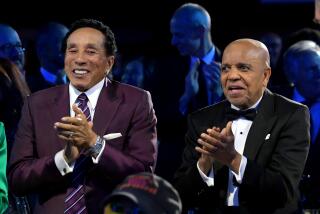JAZZ REVIEW : Bailey and Marsalis a Happy Pairing : New York festival: The 72-year-old singer and the 28-year-old trumpeter joined in a memorable version of ‘The Battle Hymn of the Republic.’
- Share via
NEW YORK — Festivals make strange bedfellows. Both the Wednesday and Thursday concerts at Avery Fisher Hall had as their headliners two singers normally associated with jazz, with an opening set provided by a small band featuring an adventurous young trumpeter.
The co-billing of Pearl Bailey and Wynton Marsalis was not as incongruous as it might have seemed. It was in the band of trumpeter Cootie Williams that Bailey got her start, and half buried among her shtick, the Social Security jokes, the dancing and the strutting, there was a voice that remains rich and warm and true. Bailey’s versions of “Unforgettable,” “For Once in My Life” and “Read My Mind” (this last with an admirable guitar solo by Remo Palmier) gave proof through the night that her sound was still there.
With her husband, Louie Bellson, at the drums leading a quartet that included Paul Smith at the piano and bassist Keter Betts, Bailey went through all her hit-song motions, complete with “Hello, Dolly!,” before offering a surprise ending. The 28-year-old Marsalis came back to join the 72-year-old singer in a heartfelt rendering of “The Battle Hymn of the Republic.” It was one of the JVC Jazz Festival’s memorable moments.
The opening set by Marsalis, leading a septet, consisted of two new, long, unrecorded works. The 35-minute “Uptown Ruler Suite” included a theme taken from a Beethoven string quartet, a movement involving a 12-tone row, and a piece written by his tenor saxophonist, Todd Williams. The final segment, “Down Home With Homey,” was the most engaging melodically, but throughout the suite Marsalis and his sidemen, notably Los Angeles’ Eric Reid on piano and Wycliffe Gordon on trombone, offered insightful ad-lib variations.
Marsalis’ recent work has involved a curious dichotomy. As a soloist, he has all but abandoned the early Miles Davis overtones, leaning now towards such older stylists as Cootie Williams and Rex Stewart; meanwhile, compositionally, he has moved forward into adventurous experiments in form.
His second piece, “Blue Interlude,” was more traditional in nature, with quasi-Dixieland passages (Williams switched to clarinet), skirting in and out of the blues.
If his abandonment of the 1960s Miles Davis has left a void, it may well be filled by the youthful Harper Brothers Quintet, who opened the Thursday recital. Philip Harper is as assured and fluent a trumpeter as can be heard on the contemporary scene, and he has his match in Justin Robinson, the 21-year-old alto saxophonist, and in pianist Kevin Hayes.
The hard-bop origins of this group are evident in their choice of material: Lee Morgan’s charming “Ceora,” old pieces by Horace Silver and Sonny Clark and, for good measure, an impeccable ballad medley of “I Can’t Get Started” by Robinson and “Portrait of Jennie” by Philip Harper, whose brother, the drummer Winard Harper, and bassist Eric Lemon round out this ebullient unit.
The second half of the bill was occupied by Regina Belle, a soul singer whose diminutive size was more than compensated by her stentorian voice, her two hefty female backup singers, two synthesizer manipulators, and a general ambience that was about as appropriate to a jazz festival as 2 Live Crew.
The piano recital Thursday afternoon at Weill Hall (adjoining Carnegie) by Abdullah Ibrahim (a.k.a. Dollar Brand) displayed the South African pianist in a full hour of uninterrupted, unaccompanied explorations. This was less a tour de force than a world tour, taking in snatches of Ellington, blues, West Indian motifs, gospel, and moving unpredictably from low key out of tempo ramblings to double fortissimo tremolos.
For an encore, Ibrahim stood up and sang what sounded like a mixture of an African chant and Ellington’s “Jump for Joy,” while slapping his thighs for rhythm. At 55, he remains the complete original he has been since he arrived here from Capetown in the 1960s.
More to Read
The biggest entertainment stories
Get our big stories about Hollywood, film, television, music, arts, culture and more right in your inbox as soon as they publish.
You may occasionally receive promotional content from the Los Angeles Times.








